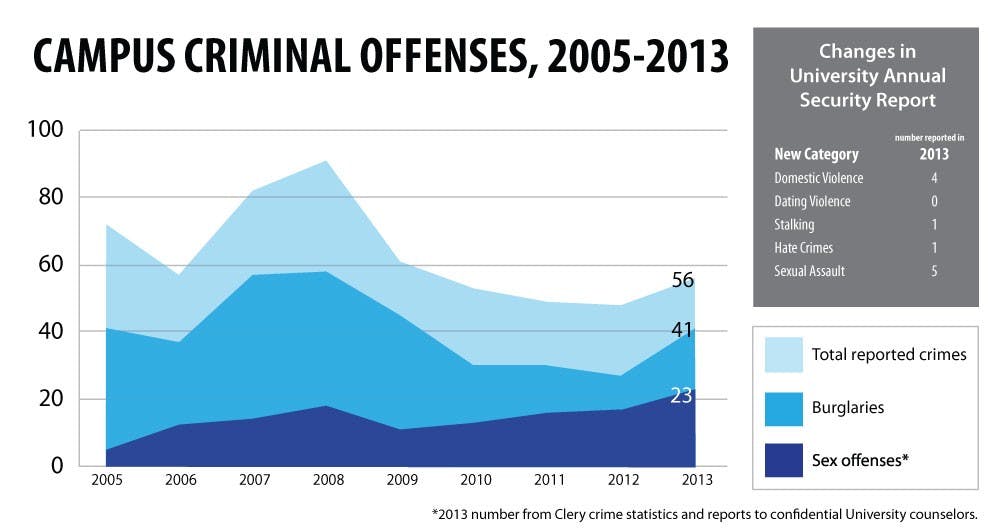The overall number of crimes reported on campus in 2013 increased to 56, compared to 48 in 2012, an increase due largely to a spike in the number of burglaries reported, according to the University’s latest Annual Security and Fire Report.
There were 30 and 27 burglaries respectively in 2011 and 2012. However, that number jumped to 41 in 2013.
In addition, changes to the Clery Act, which governs the reporting of crime statistics on college campuses receiving federal financial aid, has added five new categories of offenses and eliminated one. The report covers the 2013 calendar year and was released on Tuesday.
In order to comply with federal regulations, the University must now include the number of incidents reported for sexual assault, domestic violence, dating violence, stalking and hate crimes. Sexual assault and violence were previously covered by two categories: forcible and non-forcible sex offenses.
Within the sexual assault category, the University must now give a breakdown to include instances of rape, fondling, incest and sodomy. These changes to the Clery Act were announced over the summer for implementation in this year’s report.
Five cases of sexual assault were reported last year, all belonging to the category of rape.
In addition, four incidents of domestic violence and one incident each of stalking and hate crime, for a total of 11 incidents. There were 16 and 17 sex offenses in 2011 and 2012 respectively, although the reporting criteria were different at the time.

Sexual assault is defined in the report as “any type of sexual contact or behavior that occurs by force or without consent of the recipient of the unwanted sexual activity.”
Included under this definition are forced sexual intercourse, sodomy, child molestation, incest, fondling, rape or attempted rape. This definition is derived from the FBI’s Uniform Crime Reporting Program and the Violence Against Women Reauthorization Act of 2013. The definitions under New Jersey law differ slightly, distinguishing between sexual assault and aggravated sexual assault.
Definitions of consent also vary slightly. In New Jersey, the age of consent is 16, but individuals as young as 13 can legally engage in sexual activity if the defendant is less than four years older than the victim. The report contains several additional important points regarding consent and incapacitation, such as that “consent is not implicit in a person’s manner of dress.”
The other categories — murder or non-negligent manslaughter, negligent manslaughter, robbery, aggravated assault, burglary, motor vehicle theft and arson — did not change.

In addition to criminal offenses, the report also contains the number of arrests and judicial referrals, split into three categories: liquor law violations, drug abuse violations and illegal weapons possession. Each of these categories is further split into arrests and judicial referrals.
While an arrest involves a student being taken into custody under specific charges, a judicial referral refers to a student who was taken through the University’s judicial process but was not necessarily arrested.
The number of judicial referrals for liquor law violations increased from 28 to 36 from 2012 to 2013, while the number of liquor law arrests in the same period decreased from four to two.
The number of arrests for drug abuse violations, on the other hand, remained constant at 12 for both 2012 and 2013, twice as many as the six arrests in 2011. In 2011, 56 judicial referrals for drug abuse violations were issued in 2011, but that number has dramatically dropped since, to 45 in 2012 and 27 in 2013.
There were no murders, negligent manslaughters, robberies, aggravated assaults, or arsons on campus in 2013.
The report also contains two new sections: one titled “Personal Safety” and another titled “Safety and Security at the Princeton Plasma Physics Laboratory.” The Personal Safety section contains a list of tips for students to protect themselves and be active bystanders, as well as a link to information about registered sex offenders. The Princeton Plasma Physics Laboratory, which is located at the University’s satellite Forrestal Campus in Plainsboro, reports crimes to the Plainsboro Police department with notifications to the Department of Energy’s Princeton site office and the Department of Public Safety.
The report also indicated there were three fire reports from undergraduate buildings and one from a graduate building. Two of these involved microwaves, one involved a stove top and one involved a towel on a lamp. In addition, two graduate student buildings are not yet fully installed with sprinklers. Under future improvements, DPS said they hope to install a voice notification system to “quickly and efficiently deliver critical information to individuals during large-scale emergencies.”








